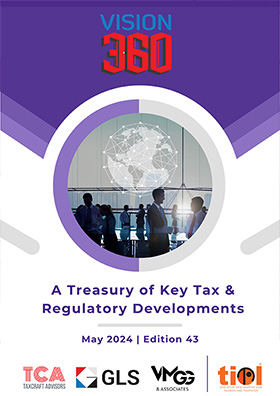Making exports truly tax-free: A paradigm shift
JUNE 01,2020
Making exports truly tax-free: A paradigm shift
By Vasu Nigam & Vinayak Mathur, Advocates, PDS Legal, Delhi
 INDIA has taken multiple steps since the 1991 reforms in its quest for acquiring a greater share in the world economy which includes inter alia, incentivization of exports.
INDIA has taken multiple steps since the 1991 reforms in its quest for acquiring a greater share in the world economy which includes inter alia, incentivization of exports.
These steps have been taken through the Foreign Trade Policy (issued and amended from time to time), the Customs Act, 1962, the Special Economic Zones Act, 2005 and now the Integrated Goods and Services Tax Act, 2017 and can broadly be put in three categories; (i) Pre-export such as the Advance Authorization Scheme, Duty Free Import Authorization, Export Promotion Capital Goods Scheme wherein inputs and capital goods can be imported without payment of customs duty, (ii) Post export such as duty drawback scheme, Merchandise Exports from India Scheme (‘MEIS') and (iii) Status based incentives such as a Special Economic Zone or an Export Oriented Unit.
The export benefit schemes have played a pivotal role in offsetting costs incurred by an exporter and thus, making Indian exports cheaper and more competitive globally. This is evidenced by the fact that exports from India have grown from USD 17.9 billion in 1991-92 to USD 330.07 billion in 2018-19. 1
A common thread running through most of the export benefits granted is their linkage to export performance. For instance, an SEZ unit must show positive net foreign exchange (NFE) i.e. the foreign exchange earned on FOB value of exports must be greater than the cost of CIF imported inputs and capital goods. Similarly, scrips under the MEIS are granted at a percentage of the value of exports made in a year. If these export obligations are fulfilled, the nectar of benefits continues to flow. However, a report of the panel established by the Dispute Settlement Body ('DSB') of the World Trade Organization (‘WTO') in October 2019 has threatened the existence of some of these schemes and has necessitated a paradigm shift in the way we reward our exporters.
WTO Dispute
As part of its WTO commitments, India is bound by the Agreement on Subsidies and Countervailing Measures ('SCM Agreement'). The objective of the SCM Agreement is to discipline the use of subsidies and regulate the actions that countries can take to counter the effects of subsidies. This agreement defines two categories of subsidies, namely, prohibited subsidies (Part II of the SCM Agreement) and actionable subsidies (Part III of the SCM Agreement). Prohibited subsidies are those which require the recipients to meet certain export targets, or to use domestic goods instead of imported goods. In the case of actionable subsidies, the complaining country must show that the subsidy has an adverse effect on its interests. The SCM Agreement also specifies what shall not be a subsidy. Footnote 1 of the SCM Agreement, appended to Article 1, provides that the exemption of an exported product from duties or taxes borne by the like product when destined for domestic consumption, or the remission of such duties or taxes in amounts not in excess of those which have accrued, shall not be deemed to be a subsidy. Thus, to remove the tax costs from an export product is permitted under the SCM Agreement.
While the SCM Agreement seeks to discipline the use of subsidies, it also recognizes that subsidies may play an important role in economic development programmes of developing country members. Accordingly, Article 27.2 read with Annex VII of the SCM Agreement provides that prohibition of subsidies specified in Article 3.1(a) i.e. subsidies contingent upon export performance shall not apply to members with a GNP per capita of less than USD 1000 per year. India's export performance-linked schemes were protected under this exception till the time it met with the condition of its GNP per capita being less than USD 1000 per year. However, as per the WTO Secretariat Notes released in 2017 and in 2018, India's GNP per capita exceeded USD 1,000 per year for the periods 2013-2015 and 2014-2016.
In 2018, the United States raised a claim in terms of Articles 4 and 30 of the SCM Agreement that since India has reached the GNP per capita of USD 1000 per year, the export incentive schemes granted by India are subject to scrutiny in terms of Article 3.1(a) of the SCM Agreement. Specifically, the United States argued that the EOU / EHTP / BTP Schemes, MEIS, EPCG Scheme, the SEZ Act and the Duty-Free Imports for Exporters Scheme ('DFIS') are contingent upon export performance and, therefore, inconsistent with Article 3.1(a) of the SCM Agreement.
The DSB Panel concluded 2 that the United States had successfully demonstrated that certain export benefits 3 are indeed subsidies contingent upon export performance and, consequently, inconsistent with Article 3.1 (a) of the SCM Agreement. Significantly, it was held that the MEIS and the SEZ scheme were in derogation of Article 3.1(a) of the SCM Agreement. Accordingly, it was recommended by the Panel that India withdraw such prohibited subsidies within the period specified in its report.
Aggrieved by the findings of the DSB Panel, India filed an appeal against the DSB Panel report before the Appellate Body of the WTO which is currently non-functional. Till the time a decision is made on India's appeal against the Panel report, the said report is not binding upon India. However, the measures being taken by the Government of India have already signaled that it is inclined to reform its export benefits ecosystem to reconcile it with the SCM Agreement.
RoDTEP Scheme
As mentioned earlier, the SCM Agreement provides that remission of such duties or taxes which are not in excess of those which have accrued, shall not be deemed to be a subsidy. On 13.03.2020, the Cabinet Committee on Economic Affairs approved the introduction of the Scheme for Remission of Duties and Taxes on Exported Products (RoDTEP) 4 which seeks to fall within the contours of permitted remissions under the SCM Agreement. This scheme will replace the existing MEIS under the FTP. Unlike MEIS wherein duty credit scrips were granted simply on the basis of the value of exports made, scrips under the RoDTEP will be granted at a rate fixed after ascertaining the taxes / duties/ levies incurred at the central, state and local level which are currently not refunded under any existing mechanism, but which are incurred in the process of manufacture and distribution of exported products. Such costs include VAT on fuel used in transportation, Mandi tax, duty on electricity used during manufacturing, etc. This scheme shall supplement the refund of input GST incurred on export supply under Section 16 of the IGST Act. Thus, the RoDTEP seeks to make Indian exports truly tax free and globally competitive while remaining within the contours of the SCM Agreement.
As of now, the Government has extended the extant FTP till 31.03.2021. The Directorate General of Foreign Trade (‘DGFT') recently issued Trade Notice No. 03/2020-21 dated 15.04.2020 and clarified that benefits under MEIS for the specified items will be available up to 31.12.2020. However, the DGFT further clarified that, as and when, an item is notified to be covered under RoDTEP prior to 31.12.2020, it would simultaneously be removed from coverage under MEIS. The process of reaching out to sector specific trade organizations has also begun to determine the hidden taxes and duties so that an appropriate rate for each product may be finalized.
While the details of the RoDTEP are a work in progress, it draws parallels from the Scheme for Rebate of State and Central Taxes and Levies (RoSCTL) on export of garments and made-ups which was notified by the Ministry of Textiles w.e.f. 07.03.2019. The objective of RoSCTL was to refund hidden taxes and levies incurred during export of garments and made-ups. The Government has recently extended this scheme for 2020-21 as well. The experiences under RoSCTL will provide valuable insights to the Government and help create a framework suitable for RoDTEP.
Points to ponder
Through the RoDTEP Scheme, the Central Government has attempted to take care of the loopholes created under the MEIS. However, reworking other export incentive schemes such as the extensive SEZ ecosystem in India will be a bigger challenge. The manufacturing units created in the SEZs have contributed immensely to Indian exports. In fact, for 2018-19, SEZs earned exports worth USD 100 billion and there are currently 351 SEZ units of which 232 are engaged in exports. 5 The setting-up of an SEZ unit was especially attractive due to the fact that SEZ units were exempted from levy of customs duties and taxes on supplies made to it as well as the subsequent export of goods and services. Further, the Income Tax Act, 1961 also deducted export earnings of an SEZ unit while calculating taxable income. All these benefits resulted in a lower tax cost and consequently, cheaper and competitive exports.
The DSB Panel reports that the exemption from IGST and customs duty on imports to SEZ units and the deduction from taxable income granted under the Income Tax Act are prohibited subsidies and considerably negate the advantages enjoyed by an SEZ unit over other exporters. Removal of these benefits will undoubtedly worry businesses which have made enormous investments in SEZs and can potentially endanger the very existence of the SEZ ecosystem in India.
The introduction of any scheme to counter the damage done on removal of SEZ-style benefits will also impose an additional burden on the Government exchequer. It is estimated that the RoDTEP Scheme will result in an additional expense of Rs 50,000 crore to the Government of India. Similar challenges will be faced while reworking other export incentive schemes as the new or modified schemes may not result in an equal amount of benefit as is currently granted. All these factors need to be taken into account before disturbing the existing scheme of benefits.
It may be noted that the SCM Agreement only deals with goods, and not services. Therefore, to the extent that the SEZ units are engaged in export of services, the DSB Panel Report will not be applicable.
While an overhaul seems imminent considering that export subsidies granted by India have already attracted countervailing measures from multiple countries, any changes at this stage are bound to have an adverse effect on Indian exports, which have already taken a massive hit due to the COVID-19 pandemic and the ensuing economic slowdown. As an alternate, the Government could consider making changes to the basis of benefits (i.e. Net Foreign Exchange earnings which is linked to export performance). As the Government walks the tightrope, it will be beneficial for it to draw from its experiences under the RoSCTL and the RoDTEP Schemes and consult with investors and exporters.
[The views expressed are strictly personal.]
1 Annual Report 2018-19, Ministry of Commerce, last accessed on 20.05.2020 at https://commerce.gov.in/writereaddata/uploadedfile/MOC_637036322182074251_Annual%20Report%202018-19%20English.pdf
2 Report of the WTO Panel dated 31.10.2019, WT/DS541/R
3 Refer to the Conclusions in Para 8 of the WTO Panel Report dated 31.10.2019, WT/DS541/R
4 PIB Press Release dated 13.03.2020 (See at https://dgft.gov.in/sites/default/files/RoDTEP.pdf )
5 Supra at 1
| (DISCLAIMER : The views expressed are strictly of the author and Taxindiaonline.com doesn't necessarily subscribe to the same. Taxindiaonline.com Pvt. Ltd. is not responsible or liable for any loss or damage caused to anyone due to any interpretation, error, omission in the articles being hosted on the site) |









 INDIA has taken multiple steps since the 1991 reforms in its quest for acquiring a greater share in the world economy which includes inter alia, incentivization of exports.
INDIA has taken multiple steps since the 1991 reforms in its quest for acquiring a greater share in the world economy which includes inter alia, incentivization of exports. 



